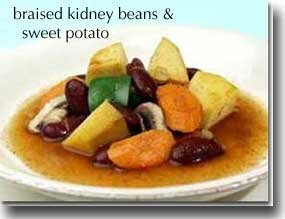healthy food tip and recipe
Today's Recipe
If you don't know what to serve for dinner tonight ...The combination of spices makes this hearty and nutritious no meat meal or side dish unusual and especially when the weather is cool. It is also very easy to prepare and needs minimal attention while cooking. Enjoy!

Ingredients:
- 1 medium onion, chopped
- 4 medium cloves garlic, chopped
- 1 TBS fresh ginger, chopped
- 1 medium carrot, sliced thin
- 1 medium green bell pepper, cut in 1-inch squares
- 2 cups sweet potatoes, cut in 1-inch cubes
- 2 cups crimini mushrooms, sliced medium thick
- 1/2 tsp cinnamon
- 1 tsp red chili powder
- 1 tsp paprika
- 1 TBS tomato paste
- 1 TBS + 2 cups vegetable broth
- 2 cups cooked or 1 15 oz can (no BPA) kidney beans, drained
- salt & black pepper to taste
- Chop garlic and onions and let sit for at least 5 minutes to bring out their hidden health benefits.
- Heat 1 TBS broth in a medium-large soup or braising pot. Healthy Sauté onion in broth over medium heat for 4-5 minutes, stirring frequently, until translucent. Add garlic, ginger, carrot, pepper, sweet potatoes, and mushrooms. Continue to sauté for another 5 minutes, stirring frequently.
- Add spices and mix thoroughly. Mix tomato paste and broth together. Cover and simmer on low for about 30 minutes stirring occasionally. Add beans, salt, pepper, and continue to cook for another 5 minutes on medium heat uncovered, or until vegetables are tender.
In-Depth Nutritional Profile for Braised Kidney Beans & Sweet Potato
Healthy Food Tip
Why do you remove the skin from salmon?
I usually like to remove the skin from fish, such as salmon, after it is cooked because it is a source of potential contaminants. I've seen one study on salmon harvested from the Great Lakes, for example, which showed 50% fewer pesticide residues (including residues from DDT) in skinned versus unskinned salmon.
In fish obtained from uncontaminated waters, I would consider the skin to be a nutrient-rich portion of the fish (containing, for example, important concentrations of omega-3 fatty acids). Although many people do not find its taste and texture appealing, the skin of salmon and other fish is definitely considered edible, and it is a valued food in some cuisines and in some restaurants as well. It's the risk of potential toxins that I am trying to avoid when I remove the skin.
I often cook the fish with the skin on when I do the Quick Broil method of preparing salmon and then remove it when it is done. I place the salmon on a hot stainless steel skillet in the broiler with the skin side down and cook for about seven to ten minutes (depending on thickness). After it is done cooking, the skin can be easily removed with a fork.
For more information on this topic, please see:
References:
Zabik ME, Zabik MJ, Booren Am, et al. Pesticides and total polychlorinated biphenyls in chinook salmon and carp harvested from the Great Lakes: Effects of skin-on and skin-off processing and selected cooking methods. Journal of Agricultural and Food Chemistry. 1995;43(4):993-1001.

No comments:
Post a Comment